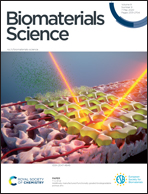Naturally available hypericin undergoes electron transfer for type I photodynamic and photothermal synergistic therapy†
Abstract
Naturally available compounds with bioactivity are potential candidates for cancer treatment. In this paper, we isolated hypericin (HC) from Hypericum sinense L. and investigated its antitumor activity both in vitro and in vivo. The nanoparticles (NPs) of HC were prepared by a nanoprecipitation process with 1,2-distearoyl-sn-glycero-3-phospho-ethanolamine-N-[methoxy(polyethylene glycol)-2000] (DSPE-PEG-2000). With light irradiation, HC NPs not only undergo efficient electron transfer to generate the superoxide radical (O2−˙) and the hydroxyl radical (OH˙) as well as energy transfer producing singlet oxygen (1O2) for photodynamic therapy (PDT), but also non-radiative decay to produce heat for photothermal therapy (PTT) with a photothermal conversion efficiency of 29.3%. This synergistic therapy, therefore, largely boosts the phototherapy efficacy of HC NPs on human cervical cancer cells (HeLa), guaranteeing a low half maximal inhibitory concentration (IC50) of only 5.6 μg mL−1. Furthermore, in vivo studies suggest that HC NPs are capable of inhibiting tumor proliferation after laser irradiation, and the main organs remain healthy, including the heart, kidneys, liver, lungs and spleen. Our results indicate that HC NPs derived from nature with excellent phototherapy efficacies are biocompatible candidates for type I PDT/PTT synergistic cancer therapy.



 Please wait while we load your content...
Please wait while we load your content...